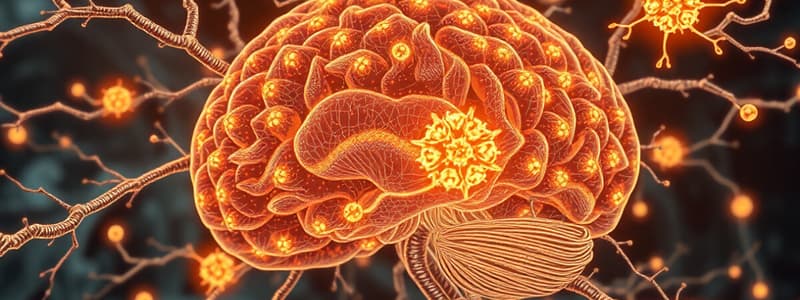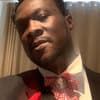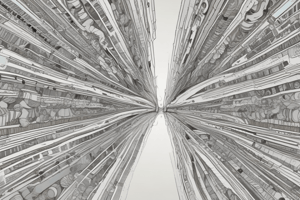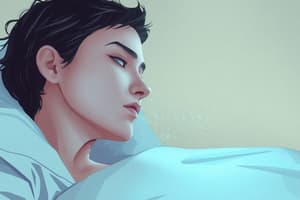Podcast
Questions and Answers
What is the effect of the sympathetic nervous system on the pupil of the eye?
What is the effect of the sympathetic nervous system on the pupil of the eye?
- No change
- Constricted
- Dilated (correct)
- Variable response
How does the parasympathetic nervous system affect the peristaltic movements of the digestive tube?
How does the parasympathetic nervous system affect the peristaltic movements of the digestive tube?
- Decreased
- No effect
- Variable effect
- Increased (correct)
Which change is most typical in the aging nervous system related to motor skills?
Which change is most typical in the aging nervous system related to motor skills?
- Increased muscle mass
- Enhanced reflexes
- Improved balance
- Flexed posture and shuffling gait (correct)
What is the primary effect of the sympathetic nervous system on the blood pressure?
What is the primary effect of the sympathetic nervous system on the blood pressure?
Which of the following symptoms may indicate a reduction in pupillary response due to aging?
Which of the following symptoms may indicate a reduction in pupillary response due to aging?
What effect does aging have on the sensory system related to taste and smell?
What effect does aging have on the sensory system related to taste and smell?
What is the role of the autonomic nervous system in regulating the urinary bladder?
What is the role of the autonomic nervous system in regulating the urinary bladder?
In assessing the gag reflex, what neurological action is primarily involved?
In assessing the gag reflex, what neurological action is primarily involved?
Which cranial nerve is responsible for the pupillary reflex test during an assessment?
Which cranial nerve is responsible for the pupillary reflex test during an assessment?
What is a common dysfunction associated with the Olfactory cranial nerve?
What is a common dysfunction associated with the Olfactory cranial nerve?
Which part of the nervous system is primarily responsible for involuntary bodily functions such as heart rate and digestion?
Which part of the nervous system is primarily responsible for involuntary bodily functions such as heart rate and digestion?
What is the effect of aging on sensory functions within the nervous system?
What is the effect of aging on sensory functions within the nervous system?
During a cranial nerve assessment, what indicates a dysfunction of the Trochlear nerve?
During a cranial nerve assessment, what indicates a dysfunction of the Trochlear nerve?
What evaluation method can help assess the gag reflex effectively?
What evaluation method can help assess the gag reflex effectively?
Which cranial nerve functions both as a sensory and a motor nerve?
Which cranial nerve functions both as a sensory and a motor nerve?
What significant change occurs in the motor functions of the nervous system with aging?
What significant change occurs in the motor functions of the nervous system with aging?
What is assessed when evaluating the cranial nerves during a neurological examination?
What is assessed when evaluating the cranial nerves during a neurological examination?
Which of the following is a symptom of progressive aging that may affect sensory functions?
Which of the following is a symptom of progressive aging that may affect sensory functions?
What reflex is evaluated by touching the back of the pharynx?
What reflex is evaluated by touching the back of the pharynx?
What rating on the five-point scale indicates no muscle movement?
What rating on the five-point scale indicates no muscle movement?
Which scale is used to grade deep tendon reflexes?
Which scale is used to grade deep tendon reflexes?
What change in muscle strength is indicated by a rating of 4 on the strength scale?
What change in muscle strength is indicated by a rating of 4 on the strength scale?
How is the Babinski reflex determined during a sensory examination?
How is the Babinski reflex determined during a sensory examination?
What is often a concern when assessing motor ability in aging individuals?
What is often a concern when assessing motor ability in aging individuals?
Which cranial nerve is primarily responsible for assessing facial sensation and corneal reflex?
Which cranial nerve is primarily responsible for assessing facial sensation and corneal reflex?
What is a common symptom of dysfunction in the VII - Facial nerve?
What is a common symptom of dysfunction in the VII - Facial nerve?
Which action would best assess the function of the IX - Glossopharyngeal nerve?
Which action would best assess the function of the IX - Glossopharyngeal nerve?
Which cranial nerve is primarily assessed by observing for tongue movement and atrophy?
Which cranial nerve is primarily assessed by observing for tongue movement and atrophy?
Which symptom would indicate a problem with the V - Trigeminal nerve?
Which symptom would indicate a problem with the V - Trigeminal nerve?
What function does the VIII - Acoustic nerve primarily assess?
What function does the VIII - Acoustic nerve primarily assess?
The X - Vagus nerve can be assessed by:
The X - Vagus nerve can be assessed by:
What does the autonomic nervous system regulate?
What does the autonomic nervous system regulate?
Which part of the brain is primarily responsible for auditory processing and receptive speech?
Which part of the brain is primarily responsible for auditory processing and receptive speech?
What is the role of acetylcholine in the peripheral nervous system?
What is the role of acetylcholine in the peripheral nervous system?
Which neurotransmitter is associated with controlling mood and sleep?
Which neurotransmitter is associated with controlling mood and sleep?
What neurological disorder is associated with a decrease in dopamine levels?
What neurological disorder is associated with a decrease in dopamine levels?
What is the function of the thalamus in the brain?
What is the function of the thalamus in the brain?
Which lobe of the brain is primarily involved in the analysis of sensory information such as pressure and pain?
Which lobe of the brain is primarily involved in the analysis of sensory information such as pressure and pain?
Which structure transmits information from one side of the brain to the other?
Which structure transmits information from one side of the brain to the other?
Which neurotransmitter is considered the major transmitter of the sympathetic nervous system?
Which neurotransmitter is considered the major transmitter of the sympathetic nervous system?
What is the effect of the sympathetic nervous system on the blood pressure?
What is the effect of the sympathetic nervous system on the blood pressure?
Which of the following statements is true regarding the peristaltic movements in the digestive system under the influence of the parasympathetic nervous system?
Which of the following statements is true regarding the peristaltic movements in the digestive system under the influence of the parasympathetic nervous system?
How does aging affect the autonomic nervous system?
How does aging affect the autonomic nervous system?
What is the impact of the sympathetic nervous system on the respiratory rate?
What is the impact of the sympathetic nervous system on the respiratory rate?
Which muscle activity in the urinary bladder is influenced by the sympathetic nervous system?
Which muscle activity in the urinary bladder is influenced by the sympathetic nervous system?
What type of saliva is secreted under the influence of the parasympathetic nervous system?
What type of saliva is secreted under the influence of the parasympathetic nervous system?
What effect does the sympathetic nervous system have on the sweat glands?
What effect does the sympathetic nervous system have on the sweat glands?
How does aging impact sensory perception in individuals?
How does aging impact sensory perception in individuals?
What is the primary responsibility of the cerebellum?
What is the primary responsibility of the cerebellum?
Which component directly surrounds and protects the spinal cord?
Which component directly surrounds and protects the spinal cord?
Which cranial nerve is responsible for the sense of smell?
Which cranial nerve is responsible for the sense of smell?
What is indicated by the inability to identify smells?
What is indicated by the inability to identify smells?
Which structure is NOT one of the protective layers surrounding the brain?
Which structure is NOT one of the protective layers surrounding the brain?
What type of function does the oculomotor nerve control?
What type of function does the oculomotor nerve control?
Which cranial nerve assessment checks for ability to look down and in?
Which cranial nerve assessment checks for ability to look down and in?
Which feature characterizes cerebrospinal fluid (CSF)?
Which feature characterizes cerebrospinal fluid (CSF)?
Which characteristic is the first cue to a change in neurologic function?
Which characteristic is the first cue to a change in neurologic function?
What does the term agnosia refer to?
What does the term agnosia refer to?
Which rating indicates minimal contractile power in muscle strength assessment?
Which rating indicates minimal contractile power in muscle strength assessment?
What is a possible interpretation for a deep tendon reflex graded as 4?
What is a possible interpretation for a deep tendon reflex graded as 4?
Which cranial nerve reflex tests involve tactile stimuli to the eye and pharynx?
Which cranial nerve reflex tests involve tactile stimuli to the eye and pharynx?
What does a positive Babinski reflex indicate in an adult?
What does a positive Babinski reflex indicate in an adult?
In a functional assessment of motor ability, which activity would be most appropriate to evaluate?
In a functional assessment of motor ability, which activity would be most appropriate to evaluate?
Which diagnostic evaluation is considered the test of choice for neurologic assessment?
Which diagnostic evaluation is considered the test of choice for neurologic assessment?
Match the following neurotransmitters with their primary functions:
Match the following neurotransmitters with their primary functions:
Match the parts of the brain with their primary responsibilities:
Match the parts of the brain with their primary responsibilities:
Match the following brain structures with their functions:
Match the following brain structures with their functions:
Match the neurotransmitter deficiencies with the associated neurological dysfunction:
Match the neurotransmitter deficiencies with the associated neurological dysfunction:
Match the following lobes of the brain with their functions:
Match the following lobes of the brain with their functions:
Match the following neurotransmitters with their effects:
Match the following neurotransmitters with their effects:
Match the following components of the neuron with their roles:
Match the following components of the neuron with their roles:
Match the areas of the brain with the specific types of functions they control:
Match the areas of the brain with the specific types of functions they control:
Match the cranial nerve with its associated function:
Match the cranial nerve with its associated function:
Match the cranial nerve with its dysfunction symptoms:
Match the cranial nerve with its dysfunction symptoms:
Match the cranial nerve with the assessment method:
Match the cranial nerve with the assessment method:
Match the cranial nerve with its corresponding number:
Match the cranial nerve with its corresponding number:
Match the cranial nerve with its clinical finding:
Match the cranial nerve with its clinical finding:
Match the cranial nerve to its main sensory component:
Match the cranial nerve to its main sensory component:
Match the cranial nerve with its primary action:
Match the cranial nerve with its primary action:
Match the autonomic nervous system component with its function:
Match the autonomic nervous system component with its function:
Match the following effects with the corresponding nervous system:
Match the following effects with the corresponding nervous system:
Match the following body systems with their respective sympathetic nervous system effects:
Match the following body systems with their respective sympathetic nervous system effects:
Match the following structures with their parasympathetic effects:
Match the following structures with their parasympathetic effects:
Match the following sympathetic effects with their descriptions:
Match the following sympathetic effects with their descriptions:
Match the following aging effects with their descriptions:
Match the following aging effects with their descriptions:
Match the nervous system components with their age-related changes:
Match the nervous system components with their age-related changes:
Match the following digestive system responses with their governing nervous system:
Match the following digestive system responses with their governing nervous system:
Match the following effects on the blood vessels with the respective nervous system:
Match the following effects on the blood vessels with the respective nervous system:
Match the cranial nerves with their primary type:
Match the cranial nerves with their primary type:
Match the cranial nerves with their primary function:
Match the cranial nerves with their primary function:
Match the cranial nerves with their assessment techniques:
Match the cranial nerves with their assessment techniques:
Match the cranial nerve to its dysfunction:
Match the cranial nerve to its dysfunction:
Match the structure with its protective role:
Match the structure with its protective role:
Match the type of cranial nerves with their functions:
Match the type of cranial nerves with their functions:
Match each cranial nerve with its mnemonic:
Match each cranial nerve with its mnemonic:
Match the following cranial nerves with their primary functions:
Match the following cranial nerves with their primary functions:
Match the following sensory examinations with their descriptions:
Match the following sensory examinations with their descriptions:
Match the following muscle strength ratings with their meanings:
Match the following muscle strength ratings with their meanings:
Match the following reflex grading with their descriptions:
Match the following reflex grading with their descriptions:
Match the following components of a physical assessment with their focus area:
Match the following components of a physical assessment with their focus area:
Match the following terms related to balance and coordination with their definitions:
Match the following terms related to balance and coordination with their definitions:
Match the following neurological examinations with their focus:
Match the following neurological examinations with their focus:
Match the following neurological conditions/tests to their associated descriptions:
Match the following neurological conditions/tests to their associated descriptions:
Flashcards
Parasympathetic Pupil Effect
Parasympathetic Pupil Effect
Constricts the pupil of the eye.
Sympathetic Heart Rate
Sympathetic Heart Rate
Increases heart rate.
Sympathetic Blood Vessel Effect (Skeletal Muscle)
Sympathetic Blood Vessel Effect (Skeletal Muscle)
Dilates blood vessels in skeletal muscle.
Parasympathetic Digestive Effect
Parasympathetic Digestive Effect
Signup and view all the flashcards
Sympathetic Digestive Sphincter Effect
Sympathetic Digestive Sphincter Effect
Signup and view all the flashcards
Parasympathetic Bronchiole Effect
Parasympathetic Bronchiole Effect
Signup and view all the flashcards
Sympathetic Bronchiole Effect
Sympathetic Bronchiole Effect
Signup and view all the flashcards
Sympathetic Blood Pressure
Sympathetic Blood Pressure
Signup and view all the flashcards
Cerebellum function
Cerebellum function
Signup and view all the flashcards
Cerebral circulation challenge
Cerebral circulation challenge
Signup and view all the flashcards
Spinal cord's role
Spinal cord's role
Signup and view all the flashcards
Vertebral column's purpose
Vertebral column's purpose
Signup and view all the flashcards
Cranial Nerve I
Cranial Nerve I
Signup and view all the flashcards
Cranial Nerve II
Cranial Nerve II
Signup and view all the flashcards
Cranial Nerve III dysfunction
Cranial Nerve III dysfunction
Signup and view all the flashcards
Cranial Nerve IV function
Cranial Nerve IV function
Signup and view all the flashcards
LOC
LOC
Signup and view all the flashcards
Mental Status Exam
Mental Status Exam
Signup and view all the flashcards
Muscle Strength (Grading)
Muscle Strength (Grading)
Signup and view all the flashcards
Deep Tendon Reflexes
Deep Tendon Reflexes
Signup and view all the flashcards
Babinski Reflex
Babinski Reflex
Signup and view all the flashcards
Cranial nerve assessment
Cranial nerve assessment
Signup and view all the flashcards
Aphasia
Aphasia
Signup and view all the flashcards
CT Scan
CT Scan
Signup and view all the flashcards
Cerebellum
Cerebellum
Signup and view all the flashcards
Meninges
Meninges
Signup and view all the flashcards
Cerebrospinal Fluid (CSF)
Cerebrospinal Fluid (CSF)
Signup and view all the flashcards
Brain's Blood Supply
Brain's Blood Supply
Signup and view all the flashcards
Spinal Cord
Spinal Cord
Signup and view all the flashcards
Vertebral Column
Vertebral Column
Signup and view all the flashcards
Mnemonic for Cranial Nerves
Mnemonic for Cranial Nerves
Signup and view all the flashcards
Neuron
Neuron
Signup and view all the flashcards
Neurotransmitters
Neurotransmitters
Signup and view all the flashcards
Acetylcholine's Role
Acetylcholine's Role
Signup and view all the flashcards
Serotonin's Impact
Serotonin's Impact
Signup and view all the flashcards
Dopamine's Function
Dopamine's Function
Signup and view all the flashcards
Frontal Lobe's Importance
Frontal Lobe's Importance
Signup and view all the flashcards
Parietal Lobe's Role
Parietal Lobe's Role
Signup and view all the flashcards
Temporal Lobe's Function
Temporal Lobe's Function
Signup and view all the flashcards
Cranial Nerve V: Trigeminal Function
Cranial Nerve V: Trigeminal Function
Signup and view all the flashcards
Cranial Nerve VI: Abducens Function
Cranial Nerve VI: Abducens Function
Signup and view all the flashcards
Cranial Nerve VII: Facial Function
Cranial Nerve VII: Facial Function
Signup and view all the flashcards
Cranial Nerve VIII: Acoustic Function
Cranial Nerve VIII: Acoustic Function
Signup and view all the flashcards
Cranial Nerve IX: Glossopharyngeal Function
Cranial Nerve IX: Glossopharyngeal Function
Signup and view all the flashcards
Cranial Nerve X: Vagus Function
Cranial Nerve X: Vagus Function
Signup and view all the flashcards
Cranial Nerve XI: Spinal Accessory Function
Cranial Nerve XI: Spinal Accessory Function
Signup and view all the flashcards
Cranial Nerve XII: Hypoglossal Function
Cranial Nerve XII: Hypoglossal Function
Signup and view all the flashcards
LOC Change
LOC Change
Signup and view all the flashcards
Mental Status Assessment
Mental Status Assessment
Signup and view all the flashcards
Sensory Examination
Sensory Examination
Signup and view all the flashcards
Pupil Response: Sympathetic
Pupil Response: Sympathetic
Signup and view all the flashcards
Heart Rate: Parasympathetic
Heart Rate: Parasympathetic
Signup and view all the flashcards
Blood Vessels: Sympathetic (Skeletal Muscle)
Blood Vessels: Sympathetic (Skeletal Muscle)
Signup and view all the flashcards
Digestive System: Sympathetic
Digestive System: Sympathetic
Signup and view all the flashcards
Respiratory System: Sympathetic
Respiratory System: Sympathetic
Signup and view all the flashcards
Aging: Nervous System Changes
Aging: Nervous System Changes
Signup and view all the flashcards
Aging: Sensory Changes
Aging: Sensory Changes
Signup and view all the flashcards
Importance of History in Neurological Assessment
Importance of History in Neurological Assessment
Signup and view all the flashcards
What is the basic unit of the brain?
What is the basic unit of the brain?
Signup and view all the flashcards
What does the axon do?
What does the axon do?
Signup and view all the flashcards
What are neurotransmitters?
What are neurotransmitters?
Signup and view all the flashcards
What does acetylcholine do?
What does acetylcholine do?
Signup and view all the flashcards
What role does serotonin play?
What role does serotonin play?
Signup and view all the flashcards
Explain the function of the frontal lobe.
Explain the function of the frontal lobe.
Signup and view all the flashcards
What is the role of the parietal lobe?
What is the role of the parietal lobe?
Signup and view all the flashcards
What is the temporal lobe responsible for?
What is the temporal lobe responsible for?
Signup and view all the flashcards
Cerebellum's Role
Cerebellum's Role
Signup and view all the flashcards
What are the meninges?
What are the meninges?
Signup and view all the flashcards
What does 'CSF' stand for?
What does 'CSF' stand for?
Signup and view all the flashcards
Why is cerebral circulation unique?
Why is cerebral circulation unique?
Signup and view all the flashcards
Spinal Cord's Connection
Spinal Cord's Connection
Signup and view all the flashcards
What are the Vertebrae for?
What are the Vertebrae for?
Signup and view all the flashcards
Cranial Nerve Mnemonic
Cranial Nerve Mnemonic
Signup and view all the flashcards
What are the Cranial Nerves?
What are the Cranial Nerves?
Signup and view all the flashcards
Autonomic Nervous System
Autonomic Nervous System
Signup and view all the flashcards
Study Notes
Neuro Assessment
- Basic functional unit of the brain is the neuron
- Neuron is composed of a cell body, dendrite, and axon
- Dendrite receives electrochemical messages
- Axon carries impulses away from the cell body
- Neurotransmitters communicate between neurons or from a neuron to a specific target tissue
- Neurotransmitters are responsible for brain activity
- Imbalances or deficiencies in neurotransmitters can cause neurological dysfunction
Neurotransmitters
- Acetylcholine:
- Major transmitter in the peripheral nervous system (PNS)
- Found in many brain areas and the autonomic nervous system
- Usually excitatory; sometimes inhibitory (e.g., heart stimulation by the vagal nerve)
- Deficiency can lead to myasthenia gravis
- Serotonin:
- Located in the brainstem, hypothalamus, and spinal cord
- Inhibitory neurotransmitter
- Helps control mood, sleep, and inhibits pain pathways
- Deficiency can lead to depression
- Dopamine:
- Found in the substantia nigra and basal ganglia
- Usually inhibitory; affects behavior, emotions, and fine motor movement
- Deficiency can lead to Parkinson's disease
- Norepinephrine:
- Major transmitter in the sympathetic nervous system (SNS)
- Located in the brainstem and hypothalamus
- Usually excitatory; affects mood and overall activity
- Rare cases of deficiency
Cerebrum
- Frontal Lobe:
- Involved in concentration, abstract thought, information storage, memory, motor function, affect, judgment, personality, emotions, and attitudes
- Contains Broca's and Wernicke's areas
- Parietal Lobe:
- Primary sensory cortex, analyzing sensory information like pressure, vibration, pain, and temperature
- Essential for spatial orientation
- Temporal Lobe:
- Contains auditory receptive areas, responsible for receptive speech, hand dominance, and long-term memory recall in most people
- Occipital Lobe:
- Primary visual cortex
- Responsible for visual reflexes and some involuntary eye movements
Brain Protection
- Skull
- Meninges (dura, arachnoid, and pia matter)
- Cerebrospinal Fluid (CSF): clear, colorless fluid that cushions the brain and spinal cord
Spinal Cord and Vertebral Column
- Spinal cord connects the brain and periphery
- Vertebral column protects the spinal cord (cervical, thoracic, lumbar, sacrum, and coccyx)
Cranial Nerves
- Olfactory (I), Optic (II), Oculomotor (III), Trochlear (IV), Trigeminal (V), Abducens (VI), Facial (VII), Acoustic (VIII), Glossopharyngeal (IX), Vagus (X), Spinal Accessory (XI), Hypoglossal (XII)
Cranial Nerve Function Summary (partial)
- Olfactory: Sense of smell
- Optic: Vision
- Oculomotor: Eye movement, pupil constriction
Brain Tumors (partial)
- Primary Brain Tumors:
- Localized (begin within the brain)
- Can be benign (slow-growing) or malignant (fast-growing)
- May spread to surrounding tissues
- Glioma: arise from brain tissue
- Meningioma: arise from the protective coverings of the brain
- Acoustic Neuroma: benign tumor of the 8th cranial nerve
Studying That Suits You
Use AI to generate personalized quizzes and flashcards to suit your learning preferences.





